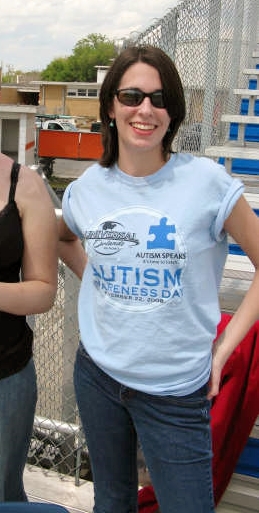"Please snip!"
Yes, you read that right! We did trim take two today and as you can tell, it went really well, beyond my wildest expectations. He was ACTUALLY REQUESTING THE CUTTING by the end! I cannot tell you how exciting that is, but I think you know.
So, here's the part where you wonder, what did we change that made us getsuch a different result this time? For one thing, we minimized the sensory load where we could. We did the trim inside the hairdresser's house, which really took a lot of the environment stress away. We also blew the hair off of him immediately when it fell, and tried to keep it from falling on him in the first place. And we did it in three snip bursts, counting them to make sure he knew how long he had to put up with it each time (which seemed to really help). We also didn't make him wear the hairdresser cape when he refused (and, for the first time, he explained why - it's too tight around his neck).
The real keys to success, however, were these: listening and rewarding. The hairdresser said the scissors were taking too long, and she wanted to use the clippers. Well, behavior is communication, and it was DEFINITELY communicated that those clippers were allowed nowhere near his head. (And continued to be communicated for ten loud minutes, until I convinced the hairdresser to heed him and go back to scissors.) Had we kept trying for the clippers, we would not have had a successful haircut. The hairdresser said, he just needs to see that the clippers don't hurt. But we need to trust that he knows himself and his needs and actually listen - and once we did we got the outcome we wanted.
The other key was the reward. Normally, I brought candy and would give him M&Ms in exchange for snips. It occurred to me, though, that Legos are much stronger reinforcers for him (like many kids, he's super into Legos), and so before I came I bought a Lego Juniors Spiderman set. Best. Idea. Ever. I opened it up and showed him the pieces, and explained the deal. Every time he did three snips, which we counted together, he'd get one Lego to add on to the figure (going in the order of the instruction book, of course).
It worked AMAZINGLY. At the end, I was showing him the next Lego he needed ("Oh, you have three tires already, but you need one more!") and before I could remind him that he had to do 3 snips to get it he was on top of it! "Snip, please!" he said calmly each time (by the end), and actually held still! No screams, no fighting, heck, hardly even any fidgeting! It was awesome. By the end, we had a happy boy, a fully assembled Spiderman set, and the best haircut I've ever seen him have. Oh, and a very, VERY happy nanny!
We had to get creative, yes, but after months of trial and error I think we've finally found the magic formula to a stress free haircut!
-Creigh

 RSS Feed
RSS Feed
